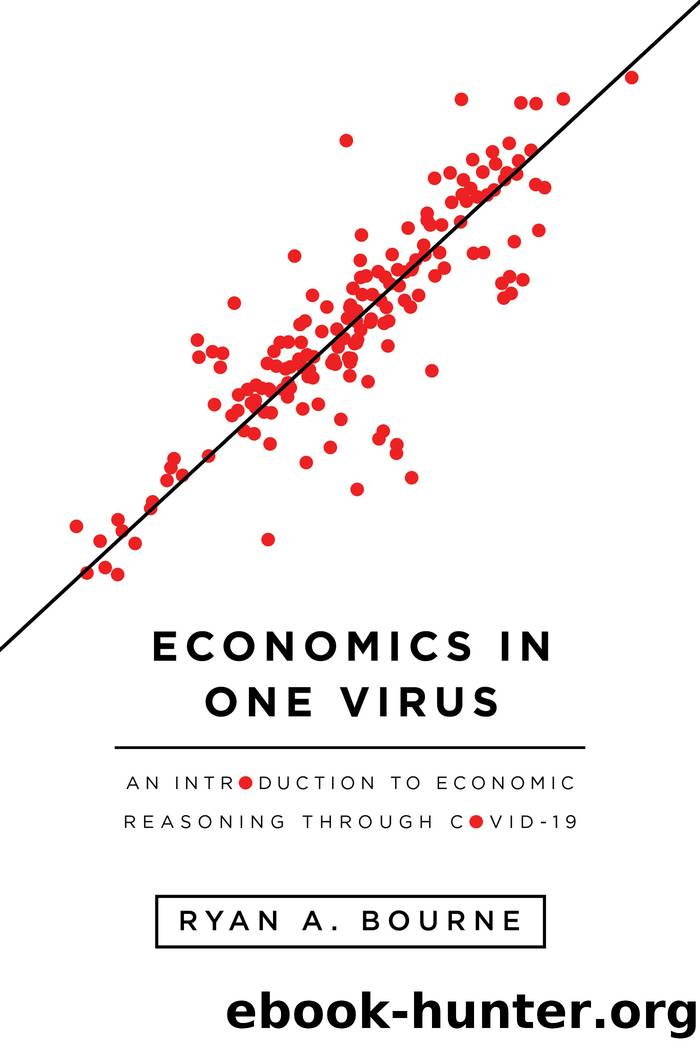Economics in One Virus by Ryan A. Bourne;

Author:Ryan A. Bourne;
Language: eng
Format: epub
Publisher: Cato Institute
Published: 2021-04-15T00:00:00+00:00
Why Do We Think So Differently in an Emergency?
Economists agree that anti-price-gouging laws are destructive in this way. In a 2012 Initiative on Global Markets poll of top economists, 53 percent disagreed with a Connecticut bill to curb price gouging, against just 8 percent who agreed with it.25 Thatâs because economists think of prices as an outcome of supply and demand, not just something firms can set at their discretion. Firms are limited by customersâ willingness to pay and the potential to be undercut by competitors.
In fact, we all understand this in normal times, even if we donât think about it. Uber surge pricing is highly responsive to market conditions, such that when demand rises sharply, ridesharing prices jump on the app. If youâre a user, you know that when the surge price is high, you will think twice about hailing a driver. But if you really need to get somewhere, you end up putting up the cash. The system rations the service to those who most value the ride. As a result, economists have found that surge pricing increases overall economic welfare, especially of the riders.26 Most importantly, the biggest gains to welfare occur in areas underserved by taxis and public transit. Higher prices encourage more transport supply to those who most need it.27
This is unsurprising. Prices send signals to drivers about where it is most lucrative to go out and work. Even if it remains difficult to find a ride when the immediate demand surge occurs, the higher price attracts more drivers to stay on the road rather than go home. In the future, it will incentivize them to hit the surging area at peak time. As Russ Roberts says, âyou get more stuff when you let the price go up.â28
Some businesses clearly understand the adverse consequences of keeping prices artificially low. One Danish store charged a relatively low price for a customer buying the first bottle of hand sanitizer but a much higher price for any additional bottles after that.29 There were all sorts of creative workarounds consumers could have adopted to ensure that they did not ever pay the higher price. But at least the business was acknowledging the large economic costs associated with both hoarding and unmet demands of those who valued the product more highly.
The broader problem, however, is that when crises hit, our tolerance for market pricing seemingly goes out of the window. A particularly tragic example of misguided price controls occurred in San Francisco during this pandemic, when the city capped the fees that UberEats and other delivery apps could charge restaurants at 15 percent in order to âhelpâ the restaurant industry during this difficult time.30
Lo and behold, when you cap prices below market rates, you get less of the economic activity. UberEats simply removed services from part of the city. It explained that this was because the price cap was below their operating costs for delivery to the Treasure Island area, making it uneconomical to serve it. But it was the poor communities there who suffered from a reduction in the food delivery service.
Download
This site does not store any files on its server. We only index and link to content provided by other sites. Please contact the content providers to delete copyright contents if any and email us, we'll remove relevant links or contents immediately.
International Integration of the Brazilian Economy by Elias C. Grivoyannis(57323)
The Radium Girls by Kate Moore(10907)
Turbulence by E. J. Noyes(7039)
Nudge - Improving Decisions about Health, Wealth, and Happiness by Thaler Sunstein(6633)
The Black Swan by Nassim Nicholas Taleb(6191)
Pioneering Portfolio Management by David F. Swensen(5606)
Rich Dad Poor Dad by Robert T. Kiyosaki(5149)
Zero to One by Peter Thiel(4824)
Man-made Catastrophes and Risk Information Concealment by Dmitry Chernov & Didier Sornette(4736)
Secrecy World by Jake Bernstein(3782)
Millionaire: The Philanderer, Gambler, and Duelist Who Invented Modern Finance by Janet Gleeson(3569)
Skin in the Game by Nassim Nicholas Taleb(3460)
The Age of Surveillance Capitalism by Shoshana Zuboff(3422)
The Money Culture by Michael Lewis(3284)
Skin in the Game: Hidden Asymmetries in Daily Life by Nassim Nicholas Taleb(3264)
Bullshit Jobs by David Graeber(3180)
The Dhandho Investor by Mohnish Pabrai(3168)
The Wisdom of Finance by Mihir Desai(3079)
Blockchain Basics by Daniel Drescher(2891)
